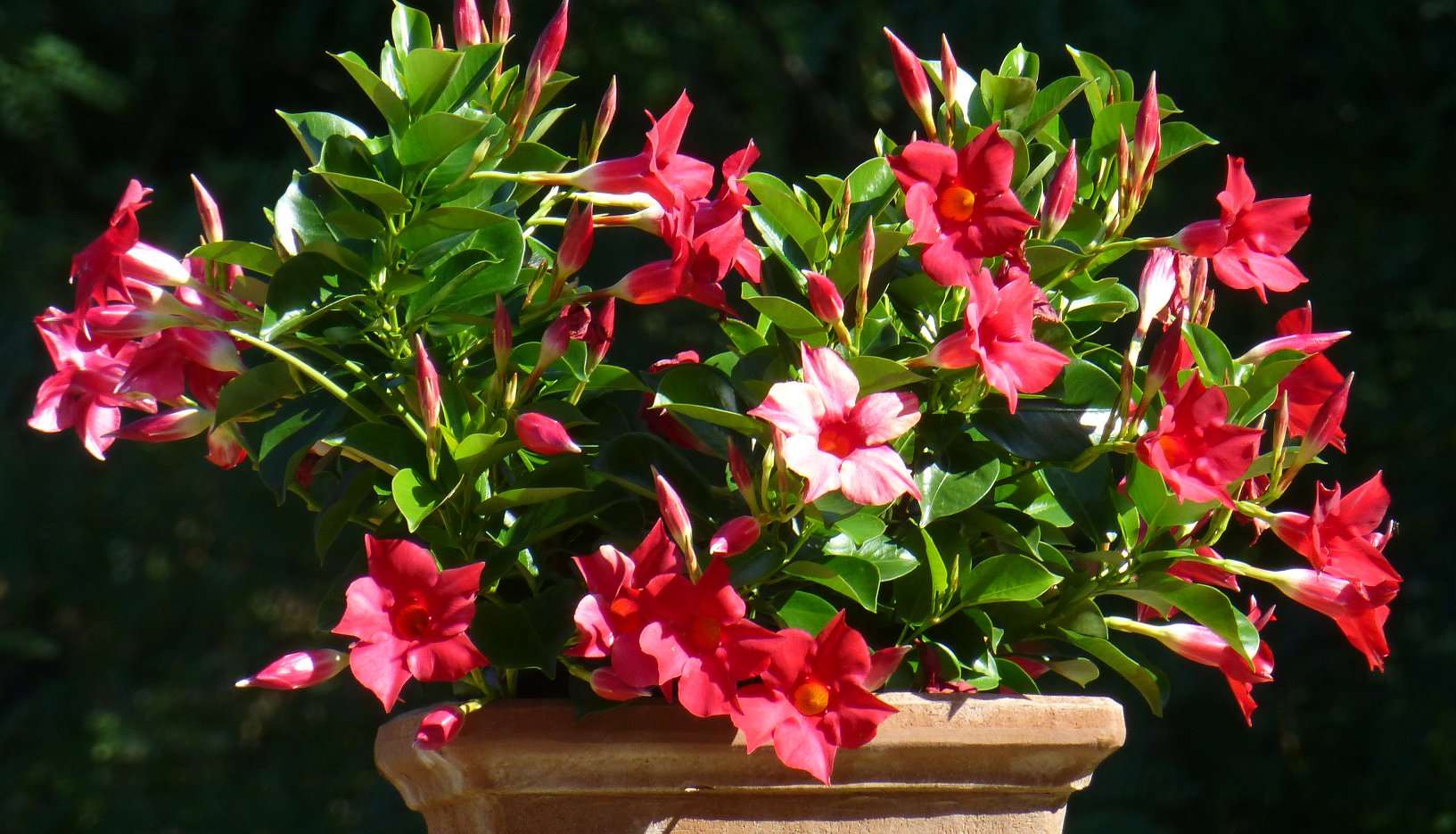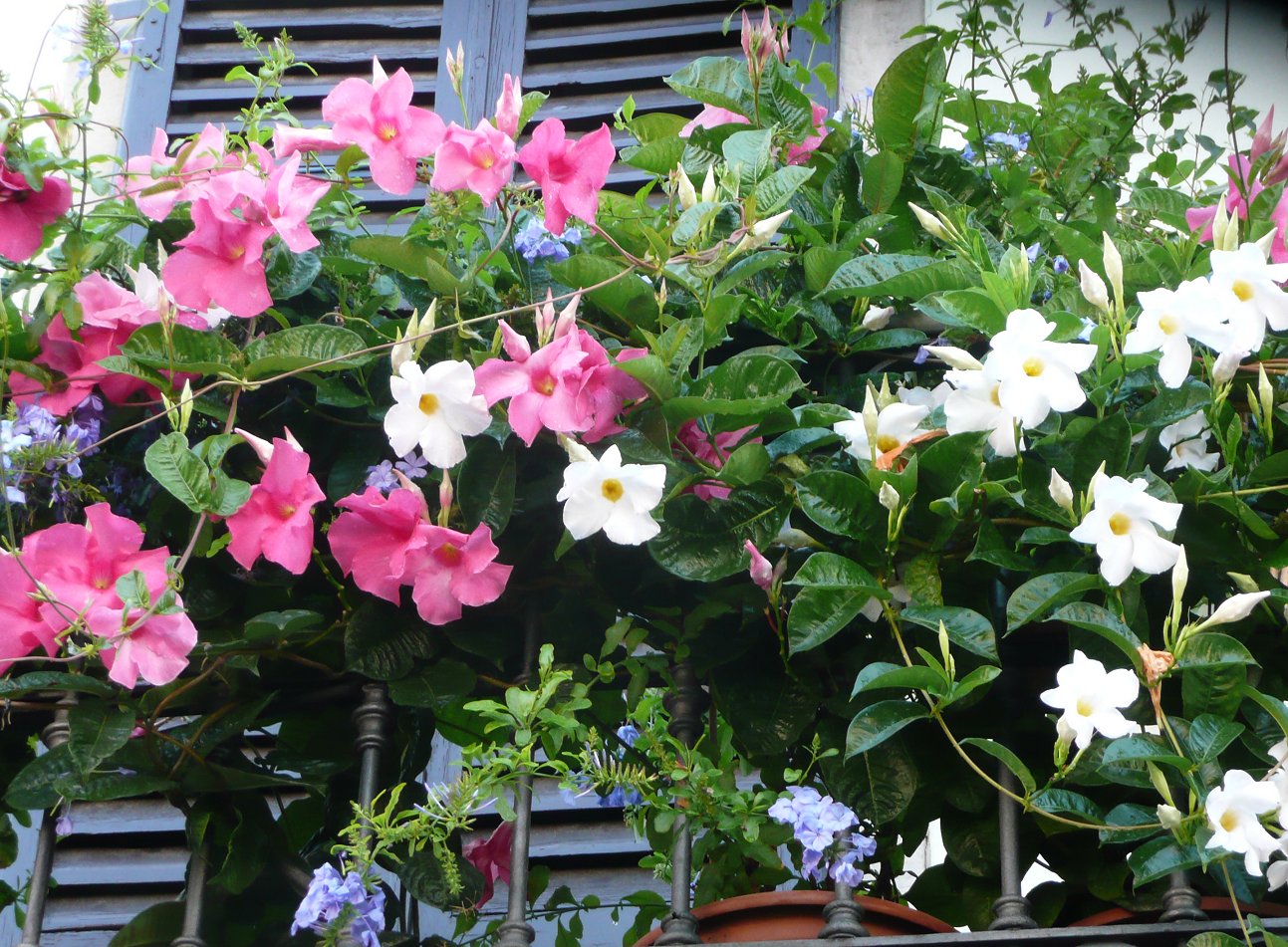Rio Dipladenia is a beautiful, low-maintenance, bushy perennial that has recently gained popularity.
If you’re in the market for a flowering plant that attracts pollinators and hummingbirds and can thrive in a pot or the ground then read on to learn everything you need to know about Rio Dipladenia!

How to Identify Rio Dipladenia
Rio Dipladenia is a bushy tropical plant with shiny green leaves and flowers that look like colorful trumpets. Rio can be a few feet tall and a couple of feet wide; they can be found in a variety of colors like yellow, orange, white, or pink.
While often confused with Mandevilla, the best way to distinguish Dipladenias from Mandevilla (which do look similar!) is that Dipladenias are shorter and bushier whereas Mandevilla is much more vine-like.

Annual or a Perennial?
Rio Dipladenia is a tropical plant that thrives in hardiness zones 10 or 11.
Because Rio is a tropical plant it won’t survive in colder climates, but if yours is in a pot you can bring it inside for the winter and take it back outside in the spring. Doing this should make your Rio Dipladenia last for multiple years.
However, if you live in a colder climate that experiences frost then your Rios will die if left outside in the winter so it’s best to overwinter them.

How to overwinter Rio Dipladenia
If you don’t live in a tropical climate you still have a variety of options for how to overwinter your Rio.
According to master gardener Melinda Myers, if your Rio is potted you can bring it inside and:
- grow it like any other house plant by keeping it in a sunny place and watering it when the top inch of soil starts to get dry or
- keep your Rio in a cool dark place and water it just enough to prevent the roots from drying out
She also notes that some of your plant’s leaves might drop when moved to its new winter home and that you should avoid fertilizing until late winter unless it shows signs of needing it before then.
Is Rio Dipladenia Poisonous?
Rio Diplandenia’s white sap can cause skin irritation and allergic reactions when handled or ingested but it is typically considered non-toxic; it doesn’t appear on the ASPCA’s list of plants that are toxic to cats or toxic to dogs but you should still prevent your pets and young children from eating its leaves or flowers.
Can you Plant Rio Dipladenia in the Ground?
Rio is equally happy in the ground as it is in a pot, but I recommend growing it in a pot for convenience.
Growing your Rio Dipladenia in a pot gives you the flexibility to move it to different parts of your garden if you’re not 100% sure where you want it, and doing so also makes it possible to bring it inside during colder months if you don’t live in a tropical climate.
If you do plant your Rio in a pot make sure it’s in a pot sized appropriately to the plant – if the pot is too big the soil may hold water for too long, which can lead to root rot. Other than that, Rio Dipladenia is pretty resilient and you don’t need to worry about it becoming pot-bound.
If you decide to keep your Rio inside, it should flourish if you treat it like any other houseplant and provide it with lots of sunlight and appropriate water.
How to Care for Rio Dipladenia
Watering
Dipladenia can grow in either dry or wet conditions, but because it needs so much sunlight it’s important to make sure the soil doesn’t dry out too fast.
Provide your Rio with at least 1 inch of water per week if it’s planted in the ground or eyeball it and water more regularly if it’s in a pot since the potted plants tend to dry out a bit faster.
Pruning
Rio blooms will happen continuously as older blooms fall off and take care of themselves, but if you want to encourage new growth and flowers you could deadhead them with pruning shears just above the leaf node, but it’s not necessary.
Sun and Temperature Requirements
Because Rio Dipladenia thrives in tropical climates they need lots of direct sunlight – ideally 6 to 8 hours per day. They should also be grown in warm temperatures around 70 degrees so if you’re in a cooler climate you might want to grow yours indoors.
Sometimes even in warm climates the temperature can drop so if the forecast is predicting a temperature of 50 degrees Fahrenheit or lower just for a night or so, then we recommend you cover your Rio in a frost blanket to add some protection.
Where to Buy Rio Dipladenia
If you want to add a splash of color to your garden you can buy Rio Dipladenia in several places.
Check with your local nursery first so you can support a worthy small business, but if they don’t have any then you can always buy your Rio at Home Depot or Amazon.


